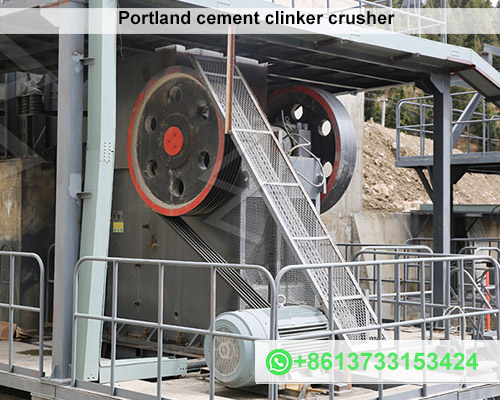Portland cement clinker crusher
Portland cement clinker crusher play a crucial role in the cement manufacturing process, specifically in transforming raw clinker into a fine powder that can be mixed with other materials to form cement. As the foundation for much of the world’s construction, Portland cement is widely used in the creation of concrete, mortar, and other building materials. Understanding the purpose and function of a clinker crusher, therefore, is essential for anyone involved in the cement production industry.

What is Portland Cement Clinker?
Portland cement clinker is the nodular material produced in the kilning stage of cement manufacturing. It is formed by heating limestone (calcium carbonate) and clay or shale to a high temperature, around 1450°C (2642°F), in a kiln. During this process, the raw materials undergo a series of chemical reactions, including decarbonation and the formation of new compounds, such as calcium silicates, which give clinker its binding properties.
Once the clinker is cooled, it needs to be ground into a fine powder, typically blended with gypsum, to produce cement. The clinker crusher is the equipment that carries out this grinding process.
The Function of a Portland Cement Clinker Crusher
A clinker crusher serves as a vital tool in the cement production process. After clinker is formed and cooled, it is fed into the crusher, where it is reduced to a fine powder. The crusher breaks down large, hard clinkers into smaller, manageable pieces for further grinding in a cement mill. The ultimate goal of this step is to produce a fine, uniform cement powder that meets the required specifications for strength, setting time, and other critical properties.
There are several types of crusher used in the cement industry, including:
- Jaw Crusher: These are commonly used in the initial crushing of clinker. Jaw crusher work by compressing large clinkers between a stationary jaw and a moving jaw. The result is a reduction in the size of the clinker chunks.
- Hammer Crusher: Hammer crusher use high-speed rotating hammers to strike and break clinker into smaller fragments. This type of crusher is known for its efficiency in reducing clinker size.
- Roll Crusher: These crusher use two cylinders that rotate in opposite directions. Clinker is fed between them, and the pressure exerted by the rolls breaks the clinker into smaller pieces.
- Cone Crusher: These crusher use a gyrating cone that compresses clinker against a fixed outer wall. Cone crusher are ideal for crushing harder clinkers.
Importance of Clinker Crusher in Cement Manufacturing
Clinker crusher are indispensable in cement plants, primarily because they improve the efficiency of the production process. By crushing the clinker into a more manageable size, the subsequent grinding process becomes easier and more efficient. This not only speeds up production but also reduces energy consumption in the cement mills, as smaller particles require less grinding effort.
Additionally, crusher help in maintaining the quality and consistency of the cement. By ensuring that the clinker is evenly crushed, crusher help prevent variations in cement properties such as setting time, compressive strength, and workability.
Technological Advancements in Clinker Crusher
In recent years, innovations in clinker crushing technology have led to improvements in efficiency and environmental sustainability. Modern clinker crusher are designed to minimize dust and emissions, making them more environmentally friendly. Some crusher now also include automated features, such as sensor-based control systems, which optimize crusher operation, reduce wear and tear, and ensure consistent output quality.
Another key advancement is the use of more energy-efficient motors and drives, which contribute to a reduction in the overall energy consumption of cement plants. In an industry where energy costs represent a significant portion of operating expenses, such improvements can lead to substantial cost savings.
Challenges and Maintenance
Despite their efficiency, clinker crusher can face challenges due to the hard and abrasive nature of clinker. Regular maintenance is essential to keep crusher in optimal working condition. This includes routine inspection of wear parts, such as hammers, jaws, and rollers, and replacing them as needed to prevent downtime.
One common issue is the buildup of clinker dust, which can clog the crusher and lead to reduced efficiency or even mechanical failure. Therefore, ensuring proper ventilation and dust control is crucial to maintaining the performance of the clinker crusher.
Portland cement clinker crusher are a vital component in the cement manufacturing process. They play a pivotal role in reducing clinker size for efficient grinding, improving production speed, and maintaining the quality of the final cement product. With advancements in technology and an increasing focus on sustainability, clinker crusher are becoming more efficient and environmentally friendly, contributing to the overall optimization of cement production processes. Proper maintenance and operation of these crusher ensure the continuous production of high-quality cement, meeting the growing demands of the construction industry.









